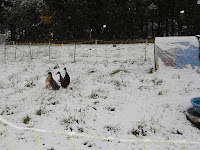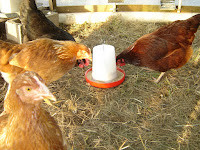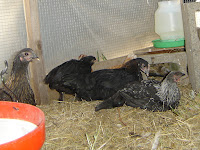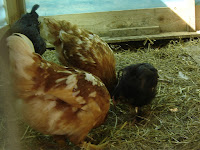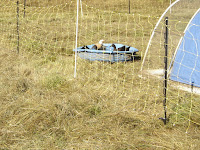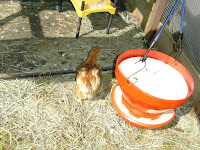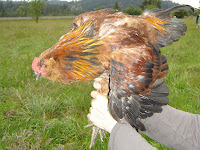I should write a children's book with this Tiny one! LOL As many of you know, Tiny is the little dwarf chicken we received with our last brood of day olds from the hatchery. She was always tiny and we assumed she would catch up eventually or that she would die because she was so small. We always made certain that she could get access to the food and water. As she reached the stage of starting to fly (a little) and roosting on a perch, we made certain that she had access to those situations too. We created a little series of steps that allowed her to perch on a roosting bar right next to her bigger but same aged peers. When she had enough perching time, she would fly down and do her other chicken activities.
Tiny is a French Black Copper Marans. We kept thinking she wouldn't survive very much longer due to her size and her round deformed body with her way too big feet. But here we are, almost four months later, and she's still with us and with some modifications to our flock and coop, she is living the chicken life. She is slightly larger than a softball and basically shaped like a ball with a head and feet. Her tail is deformed, and she does not have much of a neck. Ironically, she was fully accepted by her original flock sisters, another Black Copper Marans, and two Golden Comets.
We tried to integrate Tiny and her flock mates with some bantams, hoping that the bantams' smaller size would be just the ticket. Um... not the case with at least one bantam who wanted to dominate over the whole entire flock. But we kept trying to make it work. At least the bantams were not being too aggressive.
We had both pens/coops side by side for more than a month with the hens able to see the pullets and the pullets able to see the hens. When the other birds within Tiny's original flock were of the right size to integrate into our hen flock, we tried several different integration ideas to put the six pullets, including bantams, in with the four hens. But, at best, it had been only semi-settled for Tiny and the less dominant bantam. One factor was that blasted assertive bantam. In the bantam's attempt to be the most dominant of all, she started to crow like a rooster, even though it was obvious she was a she. The other bantam just hid inside the henhouse all day, refusing to come out for fear of being attacked by her bantam sister, or one of the hens. It was obvious that the second bantam was as low as Tiny in the pecking order. To that bantam's advantage was her speed and great flying abilities. Tiny on the other hand could only fly short distances and because of her health, needs to take several naps throughout the day.
Inside the henhouse, we added a tree branch to allow Tiny access up to a lower roost to perch at night. Tiny could navigate the branch just fine, but some of the dominant hens did not want Tiny perching on any roost. So she would sleep in the corner and usually she could coerce another of the younger birds to sleep with her in the corner.
We thought we finally had a fairly stable, albeit not quite cohesive integration solution in place. But then, as hierarchy animals sometimes do, when wanting "order," attack the weakest to get the rest in line. At the end of a dark stormy day we found Tiny huddled in the corner of the pen. She had been brutally attacked. One whole side of her tiny face, head, and comb, had been mangled. Her face looked like an eyeball placed in the middle of some hamburger meat. She was lethargic, limp, cold, and seemed ready to give up. Normally, when she is in distress, she is very vocal about it. But not this time. Not a sound.
Quickly setting up a healing station in the laundry room, we washed, medicated, and watched over Tiny. She had no interest in food. We gave her some of her favorite treats in an attempt to get her to start eating, along with some medicated water to help try to get her stabilized. We put a brooder warmer in her space, which is a small, elevated, heating plate used to act like a momma hen for newly hatched chicks. She laid down in front of the warmer with her head just under the outer edge for the warmth. She kept shaking, but eventually started to move around on her own, then eating, and drinking. Each day, she became a bit more active, vocal, and alert.
As she healed over the next few days, we tried to come up with ideas for keeping her safe inside the pen with the other birds. We decided to set up a dog crate for her in the middle of the pen, with the brooder warmer, some food, grit, water, and dry hay. We placed the crate out there for a day before transferring her in, to give the hens and pullets the opportunity to get used to it being there, with nothing but the hay inside. They actually thought this was their own personal hay dispenser. They were eating the grass from it to the point of one of them getting too much and having some crop (digestion) issues. We also set up a trail cam to help us check on the recordings to help reassess the situation.
When Tiny's face was mostly healed and some of the feathers were growing back in, we put her and her items inside the crate, inside the pen. This was extremely scary for her because two of the hens were intent on terrorizing her. Persistently, they were circling Tiny's crate, trying to figure out how to get in, and basically giving Tiny the "evil eye." If they were talking to her, we couldn't hear it, but their body language was surely sending a clear message. Tiny was hiding under her warmer for the first two hours. She was not making any attempt to come out to even eat or drink. We decided to add some extra "barriers" on the side of the crate to give her some sense of assurance that the hens could not get to her. It worked, Tiny finally started moving around inside her crate, sitting on top of the warmer, and vocalizing with her friends on that first day.
The first night, after the hens and other pullets had left the pen to go roost, I checked in and Tiny was squawking about her distress. In truth, that's a good sign from her. She was letting everyone one know "I have an issue here!" At first, I thought she was just upset about not being able to go up in the house with the other girls. But, just to be certain, I checked all the possibilities, like, was it wet in there? It was not wet, but, I discovered that her brooder warmer was not warm. The cord had become disconnected from the power source. The hens, when circling her crate, probably tripped over the cord? Not sure, but I reconnected the warmer, and within minutes, her distress cries calmed down and turned into happy cheeps. She was snuggled under the warmer and drifting off to sleep. I checked on her a few more times that night, and she was quietly sleeping in her crate, in the pen, under the henhouse. All was quiet and peaceful, at last.
Over the next few days, we would go and "supervise" Tiny outside of the crate. One of us would go sit in the pen, to give Tiny 15 or 20 minutes of interaction time with the birds, several times each day. On the first two days, it went well. She was able to peck at the ground, pull some grass, scratch the ground, look for bugs, eat some food from one of the feeders at the top of the ramp, and it "seemed" like this might eventually work. But on the third day, it was cold and gray again, and one of the hens took to targeting Tiny again, whenever Tiny attempted to get too far away from protection (one of us).
Obviously, even though it was quieter for a few days, there was not going to be peace in this particular hierarchy system as long as Tiny was in the group. We made note of which birds would just pass by or seemed unfazed by Tiny's presence. It was apparent that it was just our pair of Wyandotte hens along with that one bantam, who were determined to try to torment Tiny. There were other birds these three would harass, as well, to try to send a message. Enough of that. We talked it over and decided that even though these hens (which are not that old really, only 8 months old) and their eggs, were less important to us than giving Tiny a chance to be as healthy and safe as possible.
I placed an ad to sell the two tormenting hens. Within hours of placing the ad, a family with a farm in Washington drove 50 miles to pick them up and take them to their place. They paid a good price. Those Wyandottes are beautiful birds, great layers, and will be a great addition to any flock. That left us with the bantam issue. Luckily, another family that had an interest in the two hens, offered to take our two bantams. Before the week was over, There was a new sense of calm in the pen. We kept Tiny in the crate, though and kept the cam recording to watch, and continued with the daily Tiny interactions the next day until we felt it was safe. The remaining two hens have expressed no interest in attacking Tiny or the other pullets. Tiny has been able to sleep in the sunshine without anyone stepping on her or disrupting her space. We took the brooder warmer out of the crate, and put it into the henhouse for Tiny's first "over night" in the henhouse since being injured, and Tiny emerged in the morning looking like a princess with the other birds, ready to take on a new day.
Fingers crossed, and a much smaller flock, we have found the right flock mates for our Tiny.


